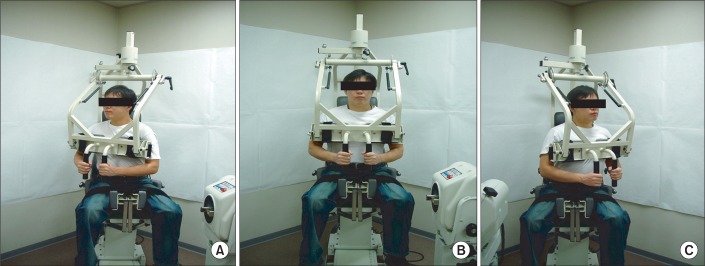Ann Rehabil Med.
2012 Dec;36(6):821-827.
Asymmetry of the Isokinetic Trunk Rotation Strength of Korean Male Professional Golf Players
- Affiliations
-
- 1Department of Physical Medicine & Rehabilitation, Chung-Ang University College of Medicine, Seoul 156-755, Korea. kmseo@cau.ac.kr
Abstract
OBJECTIVE
To determine whether there is side to side difference of the trunk rotation muscle in Korean male professional golf players. Healthy controls who did not play golf were also evaluated and compared with professional golf players. METHOD: Fifty-one professional golf players and 50 healthy controls participated in this study. Bilateral isokinetic trunk rotation strength that represented the aiming side and non-aiming side trunk rotator function in a golf swing and other parameters were evaluated using the Biodex System III Isokinetic Dynamometer at angular velocities of 30, 60, and 120 degree per second.
RESULTS
The professional golf players' peak torque and total work on their aiming sides were significantly higher than on their non-aiming side at all angular velocities. Additionally, the golf players' peak torque on their aiming side was significantly higher than those of the healthy controls only at the 60 degree per second angular velocity, but there was a slight and consistent trend in the others. Finally, the difference between the aiming side and the non-aiming side of the professional golf players and the healthy controls was also significant.
CONCLUSION
The aiming side rotation strength of the male professional golf players was higher than that of non-aiming side. The controls showed no side-to-side differences. This finding is attributed to the repetitive training and practice of professional golf players. A further study is needed to investigate if the strengthening of the trunk rotation muscle, especially on the aiming side, could improve golf performance.
Keyword
Figure
Reference
-
1. Stover CN, McCarroll JR, Mallon WJ. Feeling up to par: medicine from tee to green. 1994. Philadelphia: FA Davis;p. 97–108.2. Lindsay DM, Horton JF. Comparison of spine motion in elite golfers with and without low back pain. J Sports Sci. 2002; 20:599–605. PMID: 12190279.
Article3. Andersson EA, Grundstrom H, Thorstensson A. Diverging intramuscular activity patterns in back and abdominal muscles during trunk rotation. Spine. 2002; 27:E152–E160. PMID: 11884920.
Article4. Kumar S, Narayan Y, Zedka M. An electromyographic study of unresisted trunk rotation with normal velocity among healthy subjects. Spine. 1996; 21:1500–1512. PMID: 8817776.
Article5. Gluck GS, Bendo JA, Spivak JM. The lumbar spine and low back pain in golf: a literature review of swing biomechanics and injury prevention. Spine J. 2008; 8:778–788. PMID: 17938007.
Article6. Ripamonti M, Colin D, Rahmani A. Torque-velocity and power-velocity relationships during isokinetic trunk flexion and extension. Clin Biomech (Bristol, Avon). 2008; 23:520–526.
Article7. Lindsay DM, Horton JF. Trunk rotation strength and endurance in healthy normals and elite male golfers with and without low back pain. N Am J Sports Phys Ther. 2006; 1:80–89. PMID: 21522218.8. Ellenbecker TS, Roetert EP. An isokinetic profile of trunk rotation strength in elite tennis players. Med Sci Sports Exerc. 2004; 36:1959–1963. PMID: 15514513.
Article9. Seo KM, Kim DK, Sung SY, Park HJ. Characteristics of pain in professional golfers who visited a mobile medical clinic during the season. J Korean Acad Rehabil Med. 2008; 32:206–210.
- Full Text Links
- Actions
-
Cited
- CITED
-
- Close
- Share
- Similar articles
-
- Comparison of Isokinetic Knee Strength Profiles According to History of Knee Surgery in Korean Women’s Professional Basketball Players
- The Effect of Glenohumeral Internal Rotation Deficit on the Isokinetic Strength, Pain, and Quality of Life in Male High School Baseball Players
- Comparison of Isokinetic Strength of Knee and Pulmonary Function between Collegians and Hockey Players in College
- Isokinetic Muscle Strength and Muscle Endurance by the Types and Size of Rotator Cuff Tear in Men
- Trunk Muscles Strength as a Risk Factor for Nonspecific Low Back Pain: A Pilot Study


